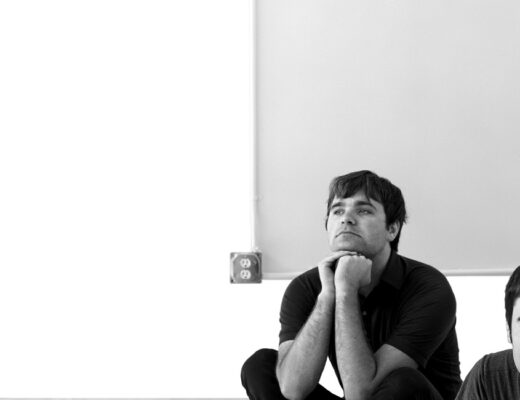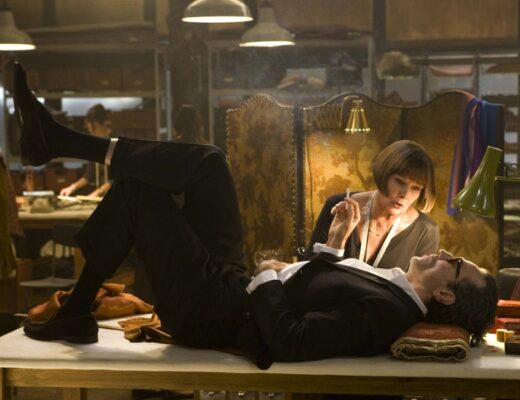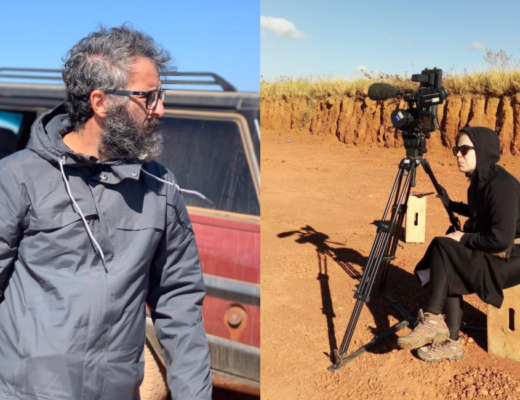Padre Pio
Disclaimer: It’s important to acknowledge the severity of the accusations of abuse made against both Shia LaBeouf and Asia Argento, and clarify that while some of the language used in this review might not do justice to the weight of these allegations, no word written here is intended to downplay abuse or sexual violence of any kind, help whitewash anyone’s image, or contribute to a public redemption campaign that may or may not be sincere.
Abel Ferrara‘s late style has been marked by a preoccupation with the end. Last year’s oneiric cyberthriller Zeros and Ones traced pandemic-era paranoia onto a crumbling dystopia, while his 2020 drama Siberia imagined the apocalypse as a miasma of bad memories, nightmares, and terrifying visions. Even his kaleidoscopic Pier Paolo biopic Pasolini eschewed convention by focusing on the final days of the iconic Italian writer and filmmaker, while refracting his life through the prism of his art — an approach not dissimilar to Paul Schrader’s take on the life of Yukio Mishima in Mishima: A Life in Four Chapters. Earlier in his career, the one-time porn director explored themes of addiction and redemption through gritty cult films such as Bad Lieutenant, King of New York, and The Addiction — tales of damaged people navigating a ruthless, seemingly amoral world — before augmenting his exploitation sensibilities with techno esoterica, starting with the William Gibson adaptation New Rose Hotel in 1998.
His latest outing, Padre Pio, could be characterized as a return to a pre-tech-anxiety period for the Bronx-born filmmaker, who moved from New York to Rome two decades ago, fed up with the rapid gentrification of his beloved city, as well as continuing difficulty with finding funding for his projects in America. While he never abandoned the unflinching interiority of his early films, there was a noticeable outward turn around the beginning of the new millennium. Ferrara’s characters no longer just grappled with their inner lives and immediate surroundings, but saw their turmoil projected onto the world at large. Padre Pio trims that scope, although the grim sense of foreboding that has been a staple of his late-career work remains very much intact.
At the end of World War I, the young friar Padre Pio (Shia LaBeouf) arrives in San Giovanni Rotondo, a small community in Apulia, Italy. The village is about to hold its first free elections, and tensions are high: the socialists are split on the question of reform vs. revolution, while reactionaries — made up of landowners and generals, aided by the police — scheme to remain in power by any means necessary. Padre Pio’s eccentric behavior and emotional instability put him at odds with the religious establishment, but his words and open vulnerability bring comfort to the afflicted, as the villagers struggle with social unrest, poverty, and illness. But while he manages to offer comfort to others, he himself is tormented by his troubled past, manifesting as visions of the devil, who warns Pio of the coming horrors that will befall the world. As the political violence begins bleeding into the streets, so too does the priest’s spiritual anguish intensify, before things, inevitably, take a turn for the tragic.
Ferrara loves complicated characters, both on the screen and off. Be it Harvey Keitel’s titular Bad Lieutenant, a demented, drug-snorting philanderer searching for redemption, or Ms. 45‘s Thana (played by the late Bad Lieutenant co-writer and close friend of Ferrara’s, Zoë Lund, who was once described as the queen of drug users by Richard Hell), a rape victim turned ruthless avenging angel, the now-sober writer-director has always felt an affinity for people on the margins of morality. And given his own struggles with drug abuse, and his hard-won, decade-long sobriety, it might not come as a shock that he was drawn to LaBeouf, who, when approached for the role, was on an acting hiatus and receiving inpatient treatment, following accusations of abuse and sexual battery made against him by his former partner FKA Twigs. According to the director, LaBeouf “connected very deeply with Pio’s journey in the film,” and if the actor’s newfound Catholicism — which he credits with helping him get sober, amongst other things — is any indication, it seems that he saw quite a bit of himself in the controversial, but widely revered, cantankerous mystic. Ferrara, for his part, glosses over the more sordid aspects of Pio’s life, which include allegations of sexual misconduct and mishandling of church funds, and opts for a more abstract approach, paralleling Pio’s crisis of faith with the looming specter of fascism, which would soon bring with it the horrors of totalitarianism, genocide, and war.
Padre Pio is the work of a dyed-in-the-wool iconoclast, far beyond being concerned with pleasing an audience. However, his impressionistic take on the Catholic saint’s life and the largely forgotten massacre that took place in close proximity to him once again brings the audience face to face with the apocalypse. According to Ferrara, “You’re looking at the end of the world,” one not mediated by computer screens and sprawling information networks, but good old-fashioned moral decay and 20th-century authoritarianism. We see just how far things have deteriorated in this small town when Asia Argento — whose alleged sexual assault of actor Jimmy Bennett is also worth noting here — cameos as the “Tall Man,” a depraved character who confesses to lusting after his daughter, to which he is scolded by an irate Pio telling him to “shut the fuck up” and “say Christ is Lord,” before being angrily sent away. It’s a bizarre scene that, like much of the film, flirts with the ridiculous. LaBeouf is characteristically dedicated to the role, but the supposed “ego death” that he claims to have gone through since his allegedly abusive behavior has come to light either hadn’t yet come to pass at the time of filming, or simply didn’t translate into a less self-obsessed performance. And while the thematic connections between Pio’s punishing spiritual journey and the tempestuous political climate of post-WWI Italy are easy to light upon, the two threads never really coalesce, mainly because the fairly dull political plot dominates the runtime, while Pio himself is relegated to the background, mostly seen either praying, crying, or yelling inside his cramped living quarters. The most egregious decision, however, was to have the Italian supporting cast deliver their dialogue in English, robbing their scenes of much-needed authenticity, and imbuing them with a clumsy, almost amateurish feel.
But even with its flaws, Padre Pio can be recognized as an admirable and deeply personal effort — for both its director and its star — that still packs the occasional cinematic punch, as the flashes of profundity in LaBeouf’s performance, and Ferrara’s raw, rough-and-tumble vision are still good for a few intriguing and intense sequences. For example, the scene of a visibly tortured Pio giving communion to his congregation is intercut with socialists being gunned down by the carabinieri, boldly echoing the baptism scene in The Godfather (coincidentally, LaBeouf is slated to appear in Coppola’s next feature, Megalopolis), while shots of their dead bodies are juxtaposed with images of Christ on the cross, to especially thorny effect. Padre Pio will likely make for an interesting, if inessential, viewing experience for anyone who has been able to tune into the eccentric wavelength of Ferrara’s late period, but anyone looking for a sturdier take on faith, guilt, and redemption would do well to (re)watch Bad Lieutenant instead.
Writer: Fred Barrett
Nuclear
There’s a certain corrosive brand of unchecked, Western-centric egotism that’s required for a documentary like the condescending Nuclear to ever see the light of day, let alone premiere at the Venice International Film Festival and receive anything resembling a positive reception. Little is left to the imagination in terms of anything outside of a central purpose: providing information, usually delivered with a self-congratulatory tone, and always with a dash of patronizing smugness. There’s so much it assumes viewers don’t know about basic world history (and, as the title suggests, about nuclear power as well) and would never know unless they were informed about it here. Basically, it’s the type of inoffensive educational video you’d throw on while substituting for a third-grade science class, except it goes on a bit longer than the allocated 45-minute period would allow. Lesson plans for two consecutive days? That’s about the peak of Nuclear’s merits and its only noteworthy accomplishment.
It should be of little surprise, then, to see Oliver Stone’s name attached as the film’s director and narrator — though, to claim he “directed” this PowerPoint of a film is a bit of a stretch; “assembled” is more accurate — as the now 75-year-old continues to pompously assume that he still knows better and more than all, and has known every particular truth far longer than you have. However, Stone’s abrasive, almost sledgehammer-like formal approach to his material has seemingly dulled over the past decade; even when his arguments were substantially shaky, or deeply homophobic, they were at least articulated with a degree of urgency and hoopla that was engaging if not edifying. But the man’s on clear auto-pilot these days, blankly shuttling off from one locale to the next, looking as out of touch as ever when interviewing people half his age — including, I shit you not, a “nuclear power influencer” who makes pro-nuclear power TikToks — and proudly embracing neoliberalism. Not only does the documentary — and, by proxy, Stone — peddle a highly politicized narrative vaguely marketed as populist, it also takes the posture of superior morality and claims the arguments being made are objective. What’s the cornerstone of objectivity? That’s right, centrism! Stone seems to ultimately side with this ideology, claiming its adherents are the only rational ones left, what with those radical socialists who are too busy dealing with that “intersectionality” bullshit. The film goes one step further when its assertions enter into the realm of complete indifference toward human life: we’re told that since there were no nuclear-related deaths at Fukushima, it proves the comparative safety of this form of energy. How about we check in with the survivors in a decade and see if that’s still the case?
At its core, what Nuclear is saying about the world isn’t too out-of-pocket or deeply unjust. If anything, its staunch acceptance of the climate science community and their alarming findings is commendable — but even to these folks, Stone comes off like a snooty, self-righteous douchebag. He lectures one scientist about the Wright brothers and how, even though they would continuously fail, they persevered until they succeeded, which is what makes the scientific method beautiful. Sure, this is definitely something that Oliver Stone, of all the qualified people in the world, has the right to expound upon, and he takes it a step further with an incoherent rant during the doc’s unhinged final ten minutes — about the power and limitless possibilities of the human brain — that swerves into new-aged mythicism territory. By the time the film gets there, you’d be hard-pressed to imagine another individual who is less equipped to engage with this discourse.
Writer: Paul Attard
Stonewalling
Huang Ji is among the last handful of Chinese directors to sneak through the portal distribution company dGenerate Films, the center of an important 2000s artistic nexus in Chinese cinema (also including Rotterdam & Locarno film festivals) that was able to facilitate an entry point for alternative and outsider Chinese filmmakers to enter the international arthouse mainstream before that pathway was essentially closed on the American end. Along with partner in filmmaking and life, cinematographer/director Otsuka Ryuji, she has become established as one of the core figures of a new wave in Chinese art film on the festival circuit.
The duo’s latest film, Stonewalling, depicts Lynn, a 20-year-old Hunanese woman dispassionately fumbling through a year of her life as she carries an unplanned pregnancy to term. She is largely isolated, perpetually scrolling on her phone, and noncommittal to her supposed life goals of learning English and becoming a flight attendant. Meanwhile, her mother, who runs a women’s clinic and is being exploited by a multi-level marketing scam on the side, has caused complications in a client’s pregnancy. The client’s more influential family — the father runs a small chain of kindergartens — is now hounding her for crippling compensation payments. After an abandoned attempt to make quick money by ovum donation, Lynn connects the dots and decides to give her baby to the other family in exchange for her mother’s debt being dropped. Lynn is quietly non-participatory in a very Gen-Z way; it’s evocative of the “lying flat” meme that dominated Chinese social media last year, but also of general social trends that have been replicated among today’s youth the world over: they are more isolated, less romantically engaged, but also less inclined toward crime and addiction — in short, they are defined by their passivity. There are also echoes of the compounding crises of fertility that have been plaguing China in recent years, as well as the filmmakers’ established preoccupation with female sexuality and reproductive health.
At a more fundamental level, this film and the works that directly surround it represent a plateauing of the trajectory of Chinese art cinema; while films like Dwelling in the Fuchun Mountains and Mama legitimately succeed and contribute to the time-honored lineage of Chinese visual artistry, it’s tempting to imagine what could have been in their place. The avant-gardism of 2000s digital has been sublimated by analog thinking and higher definitions of hyperreal HD, and while this hasn’t been unique to China — indeed, it has more or less been the story of the last 20 years of global cinema — it’s particularly disheartening given that China has had one of the largest and most radical digital arts scenes in the world. The spartan digital experiments of Huang’s peers & forebears in the dGenerate scene delving into counterculture and counterreality have been stabilized and moderated into a meticulous slow cinema process, here manifested in a formal approach of long takes, mid-distance shots, no camera movement, and little non-diegetic sound. This aesthetic mode isn’t text-independent though, as here the glacial editing schema and static, naturalistic eyeline-framed compositions firmly parallel the slow drift of our protagonist as she observes the passage of her own life largely with ambivalence and detachment. The filmmakers’ comments that Stonewalling is “observing a post-Tiktok China” also seem to bear its filmic locus; the formalism is in diametric opposition to the accelerated visual language and frenetic rhythms of the video platform. It recalls Peter Watkins’ critique about the monoform — that the growing speed of editing rhythms and heightened visual sensationalism of late-’90s/early-’00s spectacle cinema was part of a new hegemonic language of media — a specter that has haunted the world of art cinema ever since that deeply insightful misdiagnosis was levied upon us.
The Changsha setting, an archetypal middle China city, is documented with admirable precision. Famous landmarks like the enormous stone sculpture of Chairman Mao — which appears fleetingly — aside, Huang & Otsuka show off the spaces that are endemic to daily life in Changsha, capturing the Hunan capital in perhaps the most authentic terms of any internationally distributed feature. We even get to hear the Changsha dialect — a variant of Xiang Chinese featuring heavy commonality with Mandarin — which is very rarely heard in feature films, even those set in this city. If you have spent much time in a city like Changsha, among the normal people that populate it, you will likely have heard dozens of stories much like the one told in Stonewalling, and met dozens of characters like those who appear in it. Babies traded transactionally, the forging of birth certificates, debt, financial hardship, gambling addiction, the dissolution of family bonds, and other intersecting crises of modernity are all part of the social tapestry. Much of this arises out of recent history: over the past generation, massive numbers of people have gone from living in post-communist rural communitarian villages, in which everyone is a near neighbor, to atomized city living, all endless rows of indistinct apartment complexes in urban centers like Changsha, which has a comparable population to New York City — indeed, the mother’s dialect here is subtly different to that of urban Changsha, likely indicating her origin in such a village. But then, such “small” cities that consumed the rural sprawl were almost instantly fled for further “upgrades”: Guangzhou, London, Australia — the dangling promise of a better life in the latter two is constantly alluded to in Stonewalling. And this is no surprise, really: if one accepts the logic that such small, negligible GDP rural communities should be abandoned for the financial opportunity of cities, surely one should abandon a city of middling opportunity like Changsha for a gigalopolis like Guangzhou or the wealth of the world’s richest countries.
The general thrust of this notion heavily parallels the urban strain of the 5th Generation of Chinese film, far less known internationally than the folk cinema of Zhang Yimou & Chen Kaige but more impactful domestically, and most notably typified by director-screenwriter Xia Gang and novelist-director Wang Shuo. Their films centered the same concerns: the loss of identity, tradition, and intimacy in cities, and the growing diaspora seeking wealth and opportunity overseas, all driven by a languid pessimism similar to what Huang & Otsuka have engendered here. But where Wang and Xia were irreverent to the point of antisociality, here their misogyny is inverted for feminism. While this parallel is due to the social prescience of Xia and others, it’s likely also a function of the recent 5th Generation’s resurgence in popularity, itself largely a function of the inward shift of Chinese cultural apparatuses and the identification of the 1980s as a semi-arcadian moment in modern China from which patriotism can be drawn. In this sense, Stonewalling is on the other side of the Hi, Mom or Leap coin, while many of the actual artists behind the original wave 40 years ago have been pushing ahead in new directions (see recent directorial work from Zhao Fei and Huo Jianqi).
But for the most part, all this is only representative of a broader cultural critique insofar as the corner of reality Stonewalling reflects is a mundane microcosm of a broader whole. The film’s observances are dissolute and unpointed. Stonewalling could never attract an audience in Changsha itself, not because of censorship, or because its social realism cuts too close to home, but precisely because it doesn’t cut, it only copies. Ultimately, very few will be satisfied by the depictional mode of operation here: imagine your own life in its most menial and ugly moments, when you are lacking motivation, unthinkingly making life decisions, dealing with family problems, embarrassing your boyfriend at a party and going home to sit on the toilet alone while your body aches, all unromantically transposed into a series of long takes with the emotional distance of CCTV footage. That is essentially what Stonewalling amounts to, a small corner of reality unflinchingly captured on the screen with earnest literalism and aestheticised within the cracks of a structure of absolute representation. Each filmmaker in this global current is contributing their own small piece to a grand cartographic tapestry for screen tourists, like the proverbial map so large and detailed it replaces the land on which it is based. Like rust to fire, the epi-artistic process at work here may ultimately be more corrosive to reality than the social media world that Huang and Otsuka so deliberately frame it in opposition to, but the film’s strengths remain notable, if not a wholesale salvation for its aesthetic deficiencies.
Writer: Noel Oakshot
Chiara
After 2017’s Nico, 1988 and 2020’s Miss Marx, Italian writer-director Susanna Nicchiarelli brings her unofficial women-of-history trilogy to a close with Chiara. While the sophisticated portrait of the Velvet Underground collaborator, singer, and countercultural icon was widely acclaimed, Miss Marx had a harder time convincing the critics, its idiosyncratic blend of period drama restraint and punk rock abandon proving too uneven for many. Chiara operates in a similar register as the latter, displaying a penchant for eccentricity and shifting tones, as it chronicles the life of Saint Clare of Assisi (or Santa Chiara in Italian). Following her through crucial years of her life, the film sees her transform from a noblewoman, eager to leave her wealth behind for a life of religious devotion, to the founder of her own religious order, the Order of Poor Ladies, today known as the Order of Saint Clare.
Like her two previous films, Nicchiarelli’s latest biopic centers the struggle of her female main character, as she navigates life on her way to sainthood. Becoming an early follower and friend of Francis of Assisi (Andrea Carpenzano), Clare (Margherita Mazzucco) vows to live a life of obedience, chastity, and poverty, but is soon forced to contend with patriarchal interference, both literally, in the form of her father, and more broadly, in frequent conflicts with the über-conservative, deeply misogynistic Catholic Church. Even the mild-mannered and forward-thinking Francis, her closest male ally, reveals himself to be occasionally cavalier about the Church’s treatment of women, leading to discord in their friendship. In a pivotal scene, a senior member of the clergy, Cardinal Ugolino (Luigi Lo Cascio), bluntly lays things out for the devoted Franciscan, after she tries to get her own monastic guidelines approved. “Women are the origin of sin,” he reminds Clare. “It’s because of women that we all die.” Like Francis, she regularly finds herself at odds with the Church, although she often takes his pious rebellion even further, outright rejecting the Church’s rigorous hierarchies in favor of radical egalitarianism.
It’s in poverty, fasting, and tribulation that Clare finds herself closest to the female saints she would eventually join the ranks of, experiencing glimpses of the lives of figures like Scholastica and Mary. Encouraged by these visions, as well as ambiguous experiences that blur the line between divine intervention and her own ability to perform miracles, she soon sees her order grow, as “the talk of Rome” inspires other women with her devotion to Christ, and love for the sick and needy of the world. Chiara‘s moments of quiet religious revelation — a vase is miraculously filled with olive oil, for instance, prompting a friar to remind everyone that every meal is a miracle — have little in common with the tortured, Kierkegaardian reflections of Scorsese’s Silence, or the hallucinatory epiphanies of Paul Verhoeven’s erotic psychological drama Benedetta. Instead, Nicchiarelli grasps at the transcendent through her numerous exuberant musical numbers that see characters frolicking through the halls of their monastery and the vast fields that surround it, with one sequence in particular calling to mind a famous shot in Carl Theodor Dreyer’s religious drama Ordet.
As the years pass — Chiara begins in 1211 and periodically drops in on its eponymous character throughout the next 17 years — Nicchiarelli keeps introducing both somber moments of despair and scenes of uninhibited elation, but ultimately chooses to end things on a breezy, joyful note. When the former cardinal returns, now as Pope Gregory IX, his extravagant lifestyle is comedically contrasted with the virtuous modesty of the women’s order. After preparing a lavish feast for the ridiculously-dressed pope, whose unruly attire requires him to use a stepladder and several helpers to get on his horse, the women return to their monastic life, at first worrying about how to feed 50 mouths with only a small loaf of bread. But as the final song plays — this time a lively Europop number, as opposed to the Medieval music that has accompanied these interludes so far — we bear witness to the film’s final miracle, as the tiny bread somehow manages to feed every woman in the order. The scene is cheesy and the song is, frankly, shockingly terrible, but after seeing the often taxing spiritual journey Nicchiarelli has put the headstrong Clare through, it’s hard not to get wrapped up in its rapturous, wonderfully odd energy.
Writer: Fred Barrett
Skin Deep
Director and co-writer Alex Schaad has made a bold gamble with his new film Skin Deep, taking what is essentially an ‘80s-style body-swap premise and crafting it into a subdued, even solemn art film about depression, relationships, and sexuality. It gives life to the old cliché about loving someone enough to let them go, to see if they come back. But what if they come back as a different person? The film begins on a peculiar note, as an old man enters a bedroom and finds the body of a young woman lying dead. The man then begins uttering “Papa” in dismay. We are next introduced to Layla (Mala Emde) and Tristan (Jonas Dassler), a young couple traveling via ship to some sort of vacation destination. They’re in love, but it’s muted and familiar; clearly, this is a couple that has been together for some time. Arriving at a secluded, bucolic island, they are greeted by the same old man glimpsed in the prologue. He introduces himself as Stella (Edgar Selge) and begins chatting with Layla, reminiscing about their time together as students while Layla expresses her deep condolences at the passing of Stella’s “father.” It’s odd, to say the least, and feels like the setup to a horror film more than anything else.
Thankfully, Schaad soon dispenses with the mystery-box plotting and explains exactly what is going on. In this isolated place, Stella’s father pioneered a procedure allowing two people to swap consciousnesses. Stella was in her father’s body and he in hers when her body suffered a sudden aneurysm. In other words, Stella’s body died with her father’s mind inside of it, and now she is trapped in him. She’s come to accept it, and is now overseeing the annual event about to take place — couples arrive for an extended two-week stay where they will swap minds and bodies with another randomly selected couple. Layla and Tristan find themselves matched with Mo (Dimitrij Schaad, the director’s brother and co-writer on the film) & Fabienne (Maryam Zaree), a slightly older couple with children who have gone through the experience before. They are a sort of heightened, mirror image of their younger counterparts — Mo is a brash and outlandish drunk while Tristan is reserved; Fabienne is confident, even sultry, while Layla is shy and hesitant. But they go through with the change, a vague process that Schaad depicts with just enough detail to make it digestible without attempting to explain it scientifically (it involves powders, some sort of medicinal tea, and then submerging bodies in a pool of water).
What follows is complicated to explain on paper, although Schaad lays it out with simple clarity for viewers; periodic title cards declare who is who at any given moment, listing the character’s names but also who is inhabiting them, i.e. Tristan (Tristan), then later Tristan (Mo), followed by Mo (Tristan) and so forth. There’s no mystery here; Schaad isn’t interested in mind games, but in exploring the complex, inter-connected dynamics that might flow from such a scenario. What would you do with a new body? And what does a new body do for depression? After all, if you can get a new brain, does that cure whatever chemical imbalance or misfiring synapse that has led to that depression? Layla flourishes while inside Fabienne’s body, and is dismayed when Tristan pulls the plug on the swaps (any member of the quartet can end the experience early, no questions asked). Further complicating matters is the presence of Roman (Thomas Wodianka), Stella’s father’s longtime companion who volunteers to swap one on one with Layla. What does Tristan do once his girlfriend’s consciousness is inside the body of a middle-aged man?
Working with cinematographer Ahmed El Nagar, Schaad has crafted a quiet, occasionally disturbing tale of a relationship in crisis. The island’s natural beauty is captured in simple, precise compositions that carefully chart the physical and emotional distances between the characters. Depending on who is occupying who at any given moment, passions are reignited or quickly snuffed back out. Mo and Fabienne prove to be wild cards, and the threat of sexual violence rears its head. But there’s also a generosity of spirit here, a non-judgmental acceptance of different body types and sorta-kinda polyamorous encounters. It’s a heady conceit, and while the energy flags toward the end while Schaad tries to terminate his various narrative strands, the film ends on a fascinating precipice. What does it mean to truly love someone? Skin Deep proffers a very specific answer to this eternal question.
Writer: Daniel Gorman









